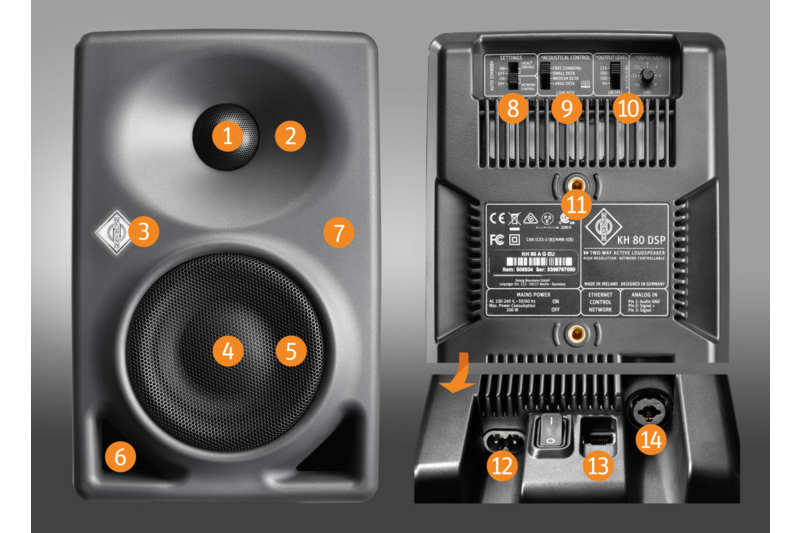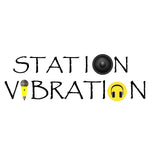Two Way Nearfield Monitor
KH 80 DSP A G EU
Ultra-compact, DSP-controlled bi-amplified near-field monitor with exceptional power reserves
- New DSP engine optimizes output to achieve reference class sound
- Mathematically optimized dispersion to deliver excellent detail in any surroundings
- Optional tools for room alignment, configuration und control
THE NUMBER 1 FOR 0 COMPROMISES
With its digital core, the KH 80 DSP enables filtering functions and room adjustment options, which brings reference level reproduction to any environment. Even with its compact design, it has extraordinary reserve capacity - as well as the classic strengths of the Neumann monitor philosophy: clearly defined dispersion angle, distortion-free design and sophisticated material selection.
THE PERFECT SOUND OF HIGHER MATHEMATICS AT WORK
The Neumann developers know every nuance, every angle and every wave reflection of the KH 80 DSP. It sounds so pure because they are directing every sound wave so precisely. The KH 80 DSP’s design is based on computer simulations that calculate with a level of accuracy that no one other than Neumann does. The Mathematical Modeled Dispersion Waveguide (MMD™) provides the studio series with a solid base for precise sound direction that remains unique. Maths has never sounded so good.
NEUMANN EVEN INCLUDES THE BIGGEST UNKNOWN FACTOR IN OUR CALCULATIONS: YOUR ROOM
It might be a project studio, an outside broadcast van, a corner at work or just a brick building: The room defines the sound. Surfaces and corners in the room cause interference, diffraction, reflection, and refraction: all are forms of distortion. For a really true sound, without acoustic-physical “accidents”, you normally need expensive equipment plus plenty of time and expertise to align it correctly – or smart algorithms. An easy adjustment to the monitor position (free standing, small/medium/large desk) is possible via the rear "Acoustical Control" switch.
For even more precise adjustments we offer the following options:
- Automatic Monitor Alignment – Automatic room correction of stereo systems using the Neumann MA 1 measurement microphone (software for Mac/PC)
- Neumann.Control – Free iPad®-App for setup, operation, and room correction of up to nine KH 80 DSP monitors via guided and/or manual alignment
A TOOL FOR EVERYONE WHO HAS PROFESSIONAL STANDARDS
Highest quality components, high-end protection systems and power reserves are what you would expect from this studio class product even under the most demanding circumstances. Its design makes the KH 80 DSP a versatile near-field monitor, which delivers professional-quality sound wherever you need it – in project and music studios, editing and broadcasting rooms or in outside broadcast vans. Some of our customers like it so much, they use the KH 80 DSP in their living rooms. Why not? After all, the KH 80 DSP delivers digital precision for a masterpiece of analog technology: your ears.
The KH 750 DSP subwoofer is the perfect complement to the KH 80 DSP.
Hundreds of good reasons from the Neumann philosophy
The KH 80 DSP has also been developed true to the Neumann philosophy for monitor loudspeakers. Every component, every shape, every signal and every wave motion is a consequence of this philosophy. No form or component is there without reason. There are hundreds of tangible reasons built into the KH 80 DSP, which all stand for exceptionally pure and neutral sound. These include, for example, curvatures of the housing that reduce edge diffraction. Also included is the pistonic output of the bass driver which does not give rise to harmonic distortions, even with the highest sound peaks. Some of these reasons are obvious in the KH 80. Others Neumann prefers to keep to itself. But together, each can be heard – sound professionals in both large and small studios all around the world can testify to this. You can read more about the Neumann philosophy for studio monitors philosophy here.
ADVICE
This device supports Sennheiser Sound Control (SSC) based on TCP and IPv6. The static IPv6 address of the device can be found using mDNS. For more information on SSC, please refer to the Sennheiser website (for example here).
Please note: We do welcome the community of users implementing custom control solutions for KH monitors based on SSC. However we do not offer technical support on using the protocol and the customer support organization will not address issues with custom monitor control applications or side effects Neumann applications. Using the SSC protocol outside the Neumann applications is done at your own risk. Neumann does not warrant SSC functionality outside of the MA 1 - Automatic Monitor Alignment Application. Future firmware releases may implement a different control protocol than SSC.

(1) In-house simulated tweeter with alloy fabric dome
- Latest modeling techniques used to minimize non-linear (harmonic and intermodulation) distortion
- Low-distortion high frequency reproduction
(2) Elliptical Mathematically Modelled Dispersion™ (MMD™) waveguide
- Smoother off-axis response
- More forgiving of diverse acoustical environments
Wide horizontal dispersion
- Freedom of movement across the mixing console
Narrow vertical dispersion
- Reduces reflections off the mixing console
(3) Two-color Neumann logo
- Displays operation status and activation of the extensive protection system
(4) In-house modelled long-throw composite sandwich cone bass driver with Extremely Linear Force Factor™ (ELFF™) and flow optimized die cast basket
- Damping of break up modes brings low distortion at high sound levels
- Linear pistonic motor gives a very low harmonic distortion even at high excursions
- Reduced air noise and improved rocking modes
(5) Robust metal grilles
- Protects against mechanical damage
(6) Large high-capacity flow-optimized bass reflex ports with pipe resonance damping
- Fast bass transient response
- Reduced bass compression at high output levels
- No coloration from organ pipe resonance
- Easier to mount in tight spaces
(7) Compact polycarbonate composite cabinet
- Robust package for a long life
- No standing wave resonances
One-piece front panel with no discontinuities
- Reduced diffraction and smoother frequency response
(8) Standby function
- Reduces power consumption when product is not in use
Control function
- Use the back panel controls or the control set defined by the Neumann.Control iPad@ app
(9) 4-position low-mid acoustical control
- Compensates for nearby desktops
- Fast acoustical set up in mobile applications
- Repeatable acoustical settings after moving loudspeakers
(10) Wide range input gain and output level controls
- Easier interfacing with signal sources
(11) Fully documented extensive mounting hardware range
- More flexibility in mounting cabinets in more diverse locations and backwards compatible to previous products
- Easy advanced planning for installations
(12) Universal double-insulated switched-mode power supply (100 … 240 V)
- One version works in any country and robust to poor quality mains supply
- Ground loops are impossible
(13) Network connector using standard IP protocol and your existing network infrastructure
- Loudspeaker system can be controlled via the Neumann.Control iPad@ app
(14) Analogue input socket can accept XLR or 6.3 mm (1/4”) Jack plugs, electronically balanced with completely symmetrical internal signal chain
- Completely symmetrical internal signal routing minimizes noises caused by external electromagnetic interference
MORE FEATURES
Production consistency due to automated computer optimized alignment in final testing
- Any KH 80 DSP is “pair matched” to any other KH 80 DSP
Separate fast acting thermo limiters for woofer and tweeter to protect the voice coils and power amplifiers
- Woofer soft clip and excursion limiters
- Fast acting and highly reliable
- Allows extraction of the maximum performance
Low heat dissipation amplifiers with large headroom and overheat limiting
- Improved transient response
- Assured reliability and safety
Linear phase crossover
- Flat phase response for timing transparency
With Neumann.Control iPad® app:
- 8 x Precision Alignment acoustical controls: Accurate and flexible alignment of the loudspeaker in the room and within systems
- Lip-sync delay: To align audio and video signals up to 1.75 frames at 50 Hz or 2.1 frames at 60 Hz
- Time-of-flight delay: To compensate for listening distance differences up to 24 m (79 ft.)
- Dimming the Neumann logo for low lighting level conditions or behind the screen applications






















